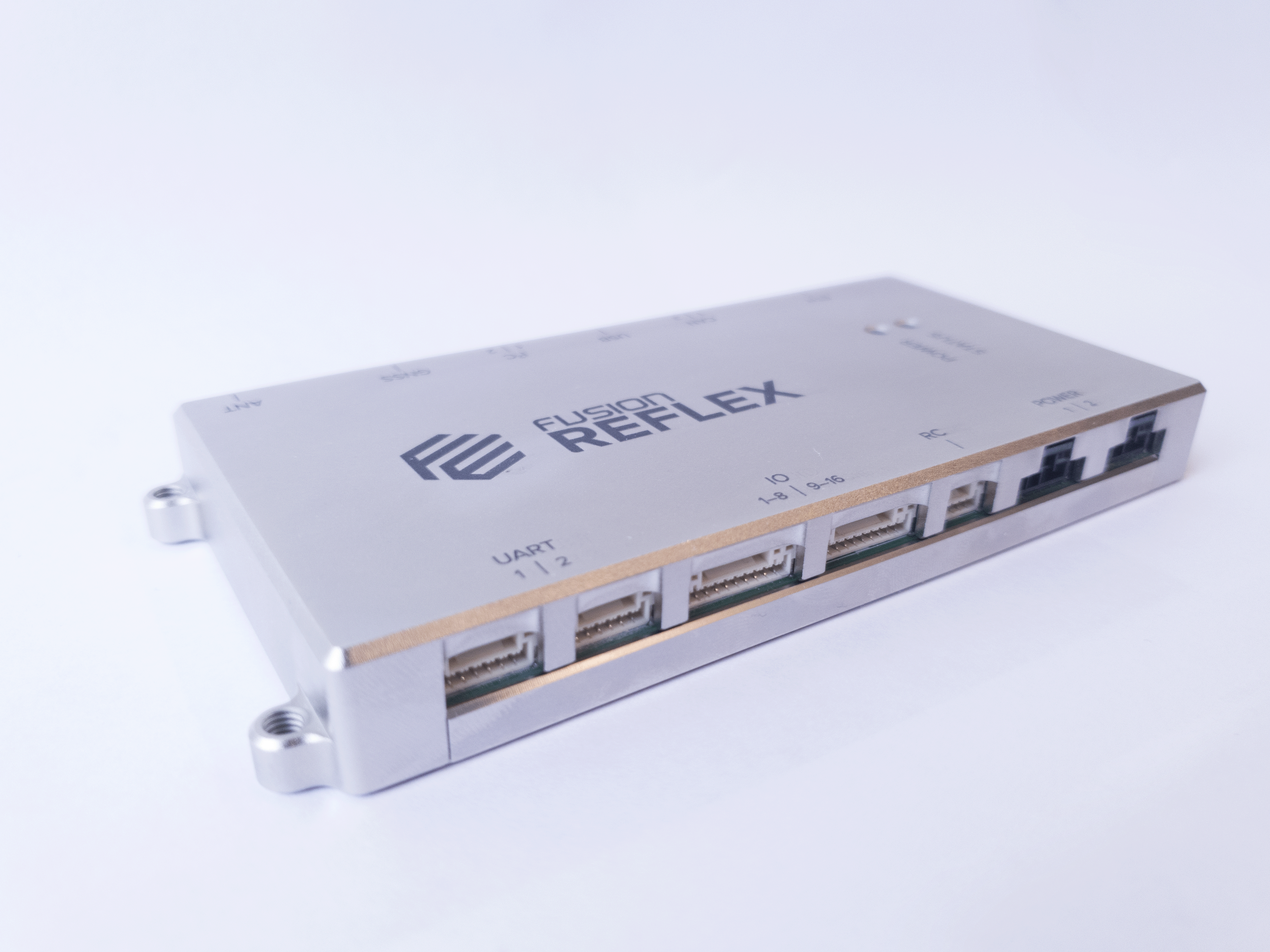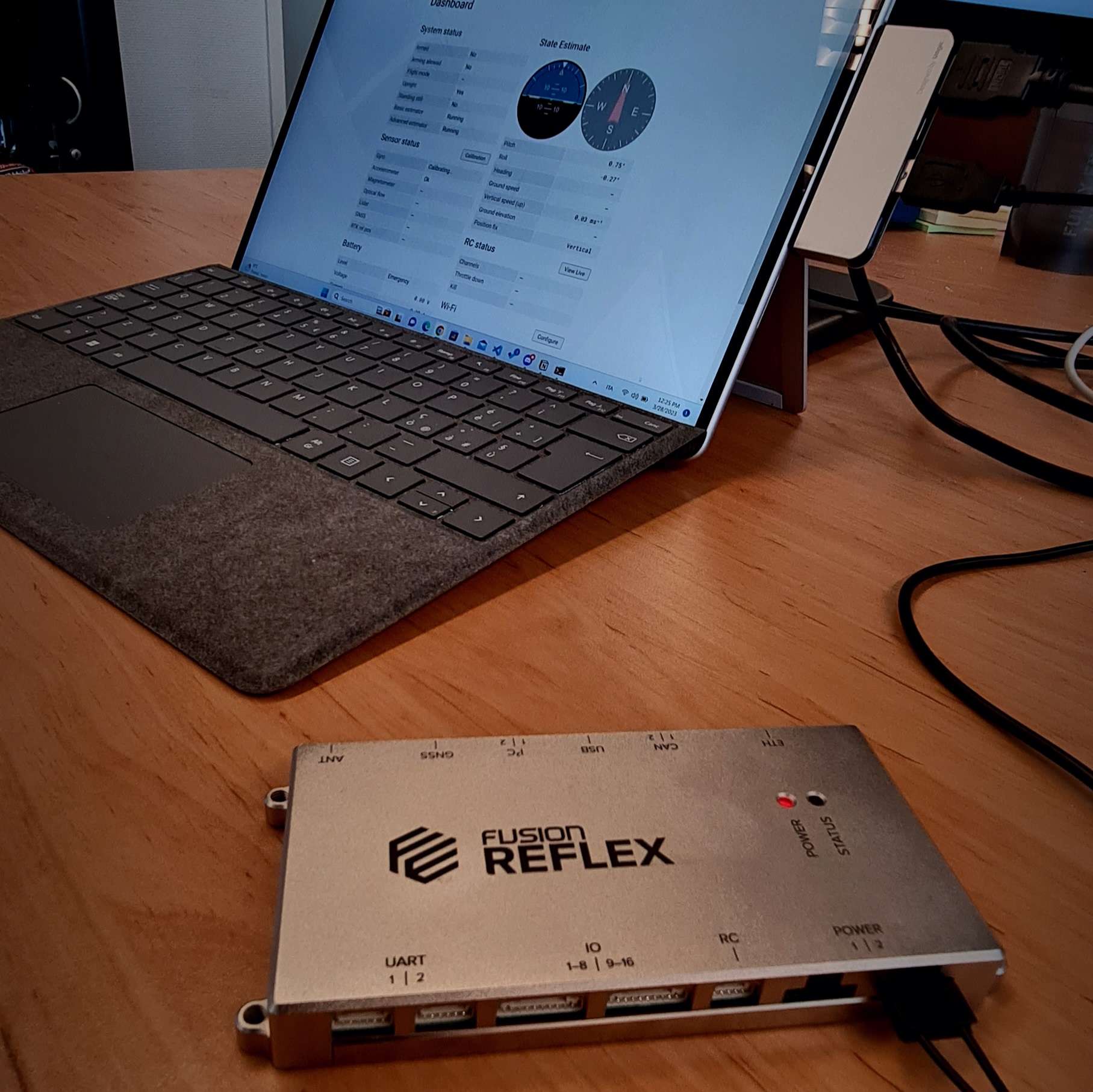Fusion Reflex – New Look
A blog by Marwan Hussein, Sanjesh Hoskopple, Jakub Valtar, and Tim Koning
Over the course of the last 3 years, our efforts have been directed exclusively at creating a next-gen flight control solution for your commercial drone. With the core technology successfully demonstrated, our technical teams have been spending the better part of the last year perfecting our flight controller to suit your needs as both a drone operator and manufacturer.
It goes without saying that we are very eager to begin entering the market and to kick-off a new age of drone flight performance. In preparation of our much-anticipated Early Access phase, we spoke to our Lead Engineers to get a better view of what has changed in the Reflex since its older proof-of-concept sibling, the Introductory Model.
Lastly, more information on how you can get your hands on a bundle of our flight controllers is discussed further towards the end, so keep on reading to see how the Reflex has evolved and how it can bring you the performance, reliability, and redundancy you look for when shopping for your next flight control solution!
Updates
Control
Having demonstrated the ability of our technology in relevant environments and extreme conditions, our most recent updates have been centred around providing a more comprehensive and reliable flying experience for the user.
Diving deeper into the control-related updates, we asked Sanjesh to run us through the latest advancements in that front:
“One of the main updates to the latest Reflex is the addition of a takeoff/landing detector. This feature detects whether the drone has taken off or landed, enabling auto disarm on landing and if the drone has been on the ground for an extended period, adding an extra layer of safety to the drone’s operation.
The Introductory Model version of the Reflex had basic flight modes, such as altitude, attitude, and position modes. However, the updated version includes new flight modes, such as Take-Off mode, Hold mode, and Return to Land mode, providing more options and flexibility for pilots on how they wish to operate their platform.”
More on the topic of user experience, several significant improvements were also made to the stick-feel a pilot experiences, additional protections were put in place, and changes to the underlying infrastructure that supports all of it were made as well:
“Another significant improvement to the Reflex is the addition of jerk-limited stick input. The computed on-board real-time feature ensures smoother pilot stick input, resulting in more stable and comfortable flight control.
To prevent the drone from banking too hard close to the ground, the updated flight controller now also includes bank angle protections. The drone’s sensor detects how far it is from the ground and auto-corrects the bank angle, even if there is input from the pilot. The drone gradually decreases the bank angle as it gets closer to the ground, providing more safety during landing and prevents the drone from making contact with the ground with its rotors.
Finally, the Reflex’s sensor fusion algorithms have undergone considerable changes, particularly for the LIDAR modules, mainly to ensure smoother flight with any onboard LIDARs, improving the reliability and accuracy of said algorithms.”
In order to successfully implement all the new control features, a fair share of impediments relating to testing, re-iterating, and even more testing had to first be overcome.
“The most challenging part of designing the updates for the Reflex was performing adequate testing to validate the new features and knowing how much is enough. While it’s possible to cover all cases during the design phase, testing the updated flight controller outdoors and in different environments reveals limitations in the design. These limitations require the engineers to either redesign the flight controller from scratch or make modifications to the existing design.
Another challenge we faced was ensuring that the new additions did not interfere with the performance of other features on the drone. We had to ensure that the new updates performed harmoniously with the existing features.”
Despite being known for the core technology inside – Incremental Non-Linear Dynamic Inversion – to achieve that level of performance, the hardware and software behind it must be equally top-notch.
Hardware & Software
The fundamental updates that the software has seen relate mainly to resolving bugs and the addition of new features. While most of the software is not being written from scratch, the team is still pushing forward to ensure that it is optimized for the new models of the flight controller. As for the hardware updates, we spoke to Jakub, our Lead Engineer, who was able to give us a detailed list of the improvements that were made to the infrastructure that holds it all together.

1. Dedicated I2C and UART ports:
In previous versions, the I2C and UART ports were combined on the same pins, leading to messy wiring and difficulty in differentiating between the two interfaces. In the new version, there are separate dedicated I2C and UART ports, making it easier to plug in and out without custom connectors.

2. Dedicated GNSS UART:
A third UART dedicated to GNSS modules has been added, with slightly different pins to sync time pulse with the modules. This update will allow for more modules to be connected without taking up any of the other ports.

3. External WiFi Antenna:
The previous version had an internal antenna, which was weak. To address this, the new version has a connector for an external WiFi antenna, providing better performance as it’s not confined to a metal box.

4. Revised RC Connector:
The RC connector has been revised to support more protocols, making it easier to connect various types of RC devices.

5. Ethernet Port:
The addition of an Ethernet port makes it easier for the team to provision the board. By connecting to a network and running the server on the network, the initial software setup can be done more efficiently.

Upcoming features
With the performance of the Reflex proven, the team’s sights are now turned towards further improving the reliability of the flight controller and enhancing the overall user experience, both from the operators’ and manufacturers’ perspectives.
One of the main updates currently being worked on is adding redundancy to the Inertial Measurement Units (IMUs), by implementing three IMUs and creating a sensor fusion algorithm for that added layer of safety.
“From the Software side, this would involve writing the drivers for the internal sensors and the triple redundant IMUs. Right now, we are testing different IMUs, for which we have a small test board to find which one is best before implementing it into the latest hardware.” Jakub notes.
In addition to IMU redundancy, new flight mode supports are being added, such as offboard mode and continuous trajectory mode, to make waypoint flight smoother. Effort is also largely being placed on integrating and improving Fault Tolerant Control (FTC), with a particular focus on detecting actuator faults and reconfiguring the controller in-flight for enhanced protection.
“Offboard mode will allow set points to be sent from an offboard computer or through MAVLink or other telemetry, while continuous trajectory mode will enable smoother waypoint flights by eliminating the need for the drone to stop at each waypoint” says Sanjesh.
Due to certain limitations involving propulsion redundancy in quadcopters, the current focus is on platforms with 6 rotors or more. Future updates will also include more autonomy and BVLOS capabilities, which will involve a lot of fault monitoring on the software level for reconfiguring systems mid-flight in case of failures.

Early Access
As we come closer to bringing the Reflex to the market, our team has been laying the foundations to properly support and enhance the flight controller as we work closely with our Early Access members.
The purpose of the Early Access phase is to give our participants the ability to test the flight controller using a hands-off approach from our end, enabling them to fly their drones at their convenience and according to their intended operations. It will focus largely on highlighting any gaps in the performance of the flight controller and will aim to greatly improve on the user experience. This will be done via a series of test plans that Fusion Engineering will be providing the participant companies with, sharing their feedback on improvements and fixes back to us, thus allowing us to promptly support them and keep their drones flying!
So what are some of the things that our Lead Engineers are looking to get out of it?
Jakub: “When we build our own drones, we tend to follow a certain procedure and pattern and we know that things will work like that. But when someone else does it, they do it using assumptions and methods we didn’t think about, so being able to observe the integration of our flight controller into a drone independently, it gives us the opportunity to see the different approaches and preferences in building drones.”
Sanjesh: “For Early Access, testing would mostly involve piloted flight within visual line of sight, within the range that the pilot can take back control. In terms of the Early Access phase, we are looking to get the initial feedback on user experience and ease of integration so that we can improve that process as well. Additionally, we are aiming to stabilize our algorithms and infrastructure by getting more flight hours on the features we can currently offer, especially on a wider assortment of frames and various operational conditions. Once that is done and our GCS is up and running, the next step would focus mostly on autonomous flight, as we are currently bound by the range because we control the settings and configuration via WiFi.”
Lastly, with our Mechanical Engineer executing all of the flight testing and pushing the Reflex to its limits, we are able to momentarily step into the shoes of a drone operator and get a better glimpse of what a drone pilot would most likely prefer. When it comes to the quality of handling, Tim emphasizes the importance of smoothing the response of the drone to any input made by the pilot and allowing the operator to easily tailor it to their specific requirements, which is made possible by allowing certain features to be tweaked to the users’ preferences.
Are you ready to pioneer the new era of drone flight control? Make sure to reach out to me at marwan@fusion.engineering to learn everything about the upcoming Early Access phase and how you can become a member! We are looking forward to seeing you in the sky!
Make sure to stay tuned on the development of the Reflex by following us on LinkedIn and subscribing to our Newsletter!




